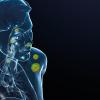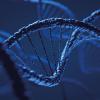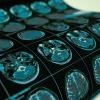The work of scientists from many disciplines led to the discovery of the double helix, 70 years ago. It has shaped biomedical science ever since.

There were several people looking for the structure of DNA at the same time and the people who really showed everybody what it was were Rosalind Franklin and her student Ray Gosling,” says Denise Syndercombe Court, Professor of Forensic Genetics at King’s College London.
“They took this beautiful photograph of a strand of DNA, and it was immediately obvious to anybody who knew that this was a helical structure,” she adds. “Photo 51” was an X-ray diffraction image of a paracrystalline gel of DNA fibre taken in 1952 by Raymond Gosling when he was a research student at King’s College London. The university describes it as “one of the world’s most important photographs”.
The measurements and gaps in the photo showed that the helical structure was “slightly displaced” and this “defined the structure of the double helix”, Professor Syndercombe Court says. Franklin – who had previously used X-ray diffraction to study the structure of coal – then used mathematical calculations to establish that it was DNA.
The story of the discovery of the double helix spans a century and a range of scientific disciplines. The research made possible since Watson and Crick’s 1953 model was published appears limitless. From medical screening of genetic diseases, to editing genetic mutations that lead to diseases and growing stem cells to replace damaged cells, dozens and dozens of applications of our understanding of the structure of DNA have been demonstrated.
The role of crystallography
Just over 70 years ago, work on DNA had begun in the Biophysics Research Unit at King’s College, when Gosling and biophysicist Maurice Wilkins – who had previously worked on the atom bomb – modified an X-ray diffraction camera by filling it with hydrogen, in order to reduce background scattering.
They photographed moistened samples of DNA fibres, and were able to show that atoms in DNA had a regular structure. Another physicist in the unit, Alec Stokes, used mathematical calculations to predict from these photographs that the DNA molecule was probably helical in shape.
Franklin had already produced images of a DNA sample in two forms – long and thin when humidity was higher than 75% (she called this “wet” or B-DNA), and short and fat when drier (called crystalline or A-DNA). The absence of reflection on the meridian in the crystalline form led Franklin to suggest it had a spiral structure. Earlier theories had suggested that phosphates and sugars were attached to the four ring-shaped nucleobases that were arranged like a stack of pancakes.
She also reasoned that because many water molecules could cling to DNA, the water-attracting phosphates must be on the outside of the helix. Franklin presented these findings at a 1951 lecture attended by American biologist James Watson, showing the patterns produced by A-DNA and B-DNA and how the two forms seemed to be produced by surrounding the DNA molecules with different amounts of water.
The role of modelling
Watson, who started his career studying birds, virus and bacterial genetics, attended a 1951 lecture by Maurice Wilkins on his findings on the structure of the DNA molecule. He joined the University of Cambridge’s Cavendish Laboratory specialising in X-ray diffraction. Also working in Cavendish was English physicist Francis Crick, who had designed underwater mines during World War 2 and had knowledge of X-ray crystallography.
In their first encounter in 1951, Watson and Crick had already discussed that the three-dimensional configuration of the gene was needed to understand heredity and reproduction. They “pursued it with single-minded focus over the course of the next eighteen months” and immersed themselves in genetics, biochemistry, chemistry, physical chemistry, and X-ray crystallography.
Already that year, American biochemist Linus Pauling had used ball and stick models and X-ray diffraction data to hypothesise that the single-stranded alpha helix comprises protein structures. Watson and Crick hadn’t conducted any DNA experiments themselves so drew on others’ research to model from X-ray data.
But there was an initial setback in their proposed model. The first model Watson and Crick built and presented to Wilkins, Franklin and Gosling, had three long twists of the sugar-phosphate chain held together by magnesium ions. Franklin realised that their model did not allow for the amount of water that DNA crystals contained, and if DNA contained magnesium ions, the water would cling to them and tear the molecule apart.
Fact file:
Selected research made possible by the discovery of the double helix
Biological sciences: mapping nematode genomes to understand comparative genome structure and evolution.
Computational genomics: using computational and statistical analysis to decipher biology from genome sequences.
Dentistry: developing a bioengineered tooth generated from a person’s own blood cells.
Diagnostics: mapping the human genome to identify genes involved in rare and common diseases.
Gene targeting: growing stem cells that can replace damaged cells and treat disease.
Epigenetics: understanding how the actions of genes can be temporarily modified to meet therapeutic targets and develop drug treatments.
Physical sciences: using cryo-electron microscopy and X-ray crystallography to understand the structure of molecules and even macromolecules inside cells.
Technology: developing CRISPR to edit the genome for research purposes, including genetically modified animal models, biofuels and food and drink.
Establishing the structure
Franklin and Gosling had continued to photograph DNA molecules, focusing on A-DNA. In one image they had exposed overnight the DNA had hydrated and the B-DNA shot was unusually sharp with an obvious X pattern and stacked DNA bases – Photo 51. They set it aside because they were working on A-DNA images.
But there was tension between Franklin and Wilkins and, shortly after the photo was taken, Franklin left King’s for Birkbeck University, leaving the photo with Gosling. Wilkins became Gosling’s PhD supervisor and Gosling showed him the photo. Wilkins then showed the photo to his friend Watson, who recognised the helical structure. “Crick had an understanding of the helical aspect of haemoglobin and once he had seen the photo he understood what it was,” Professor Syndercombe Court says.
The photo provided crystallographic evidence of the structure of DNA and led Watson and Crick to create a model with two sugar-phosphate base chains linked, conjecturing that genes come in pairs because most organisms have two parents. American chemist, Jerry Donohue, who shared their office for the year, had told Watson and Crick that the configuration for rings of carbon, nitrogen, hydrogen and oxygen in thymine (T) and guanine (G) given in most chemistry textbooks was wrong.
This led them to create cardboard models of the T and G bases in atoms, and understand how the bases fit together.
In shifting the models around, Watson realised that when adenine (A) and T were joined, they very nearly resembleda paired cytosine (C) and G, and each pair could hold together by forming hydrogen bond.
“The structure of DNA is incredibly elegant: two long strands wrap around each other in a double helix, zipped up by highly specific base pairs,” says Professor John Diffley, Group Leader of the Chromosome Replication Laboratory and Associate Research Director at The Francis Crick Institute. “It explains how DNA can be copied – after pulling the two strands apart, each strand can act as a template, using the specific base pairing to make another double helix.”

How the discovery has shaped biomedical science
Professor Diffley’s team at the Crick studies the processes involved in copying DNA. “To copy our genomes quickly and efficiently, DNA replication begins from thousands of ‘origins’, or locations, distributed across our genomes,” he says. “Over the past three decades we have used a variety of DNA approaches to build a detailed picture of how replication begins at these origins and how the process is controlled to make sure each origin is used just once in every cell cycle.
“We’re only just beginning to grapple with how all the many processes that occur on the same DNA template, like DNA replication, DNA repair, and gene transcription, are coordinated.
“What happens when the machines involved in these different processes collide? How does DNA replication deal with DNA damage, which is occurring all the time? And how is the normally exquisite regulation of DNA replication disrupted in cancer?”
Without that photo and measurements, the discovery would have been left to others
The understanding of the double helix’s structure has also been crucial in other contexts. “If I want to know how old a person is from the blood, I could investigate small molecules, usually methyl groups, that attach to the DNA. They don’t alter the sequence in any way but variably bind or fall off the DNA molecule at cytosine residues, normally in particular areas where there is cytosine and guanine next to each other, and they will influence whether a gene is switched on or off.
“There are different ‘epigenetic’ methylation patterns that influence repair mechanisms, which are not as good when we get older,” Professor Syndercombe Court adds. “But as a forensic scientist,
I have to be really careful not to step into the medical world and I have to be selective about what I use because in the complete DNA molecule there is all sorts of private information about their medical history.”
The future
Ethics will be an ongoing issue, with greater study not just of genetic sequences of a gene but the areas around the sequence. “There are many other epigenetic changes where we can look at the environmental influence on our DNA, for example,” Professor Syndercombe Court says. “Editing genes is going to be really problematic,” as we need to consider the impact of correcting the single nucleotide or sequence that, for example, perhaps leads to sickle cell disease. “While it might stop the disease, how will that impact the population generally?”
Many other areas of research are of growing interest. Professor Syndercombe Court is also part of a group taking microbiome samples from urban environments around the world. “We have an understanding of what microbes are in New York, Singapore, London, for example, in the air and on surfaces,” she says. “And we can recognise things like antibiotic resistance that may develop differently across the world.”
The possibilities afforded by the work to reveal the structure of DNA continue to appear endless 70 years later. Crick, Watson and Wilkins were jointly awarded the Nobel Prize for Physiology or Medicine in 1962. Franklin died of cancer in 1958 aged 37, and in the intervening years, the focus on the crucial role her work played has heightened. “She didn’t get recognised, as many women scientists don’t,” Professor Syndercombe Court says. “Without that photo and measurements from that photo, the discovery would have been left to others.”
Image Credit | MARTIN-O'NEILL




